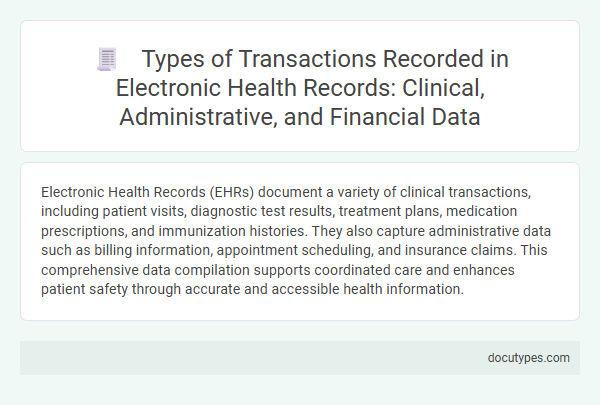Electronic Health Records (EHRs) document a variety of clinical transactions, including patient visits, diagnostic test results, treatment plans, medication prescriptions, and immunization histories. They also capture administrative data such as billing information, appointment scheduling, and insurance claims. This comprehensive data compilation supports coordinated care and enhances patient safety through accurate and accessible health information.
Introduction to Electronic Health Records Transactions
Electronic Health Records (EHRs) systematically document diverse medical transactions to enhance patient care and streamline healthcare operations. These digital records capture essential clinical, administrative, and financial data during patient encounters.
EHR transactions include patient demographics, medical history, diagnostic test results, and medication orders. They also record progress notes, treatment plans, and immunization dates to support continuity of care. Administrative transactions such as appointment scheduling and billing are integral components within EHR systems.
Overview of Data Types in EHR Systems
Electronic Health Records (EHRs) store a wide range of medical transactions to provide a comprehensive view of a patient's health history. These systems capture detailed data that supports clinical decision-making and care coordination.
- Patient Demographics - Include essential information such as name, date of birth, gender, and contact details.
- Clinical Notes - Document healthcare provider observations, diagnoses, and treatment plans.
- Medication Records - Track prescribed drugs, dosages, and administration schedules.
Your healthcare providers rely on these varied data types within EHRs to deliver personalized and effective medical care.
Clinical Data Transactions: Definition and Examples
Clinical data transactions in Electronic Health Records (EHRs) refer to the digital recording and management of patient-related health information during medical care. These transactions capture detailed clinical events that support diagnosis, treatment, and monitoring of patient health.
Examples of clinical data transactions include the entry of vital signs, documentation of medical history, lab test results, medication prescriptions, and progress notes by healthcare providers. Such records ensure accurate, real-time access to patient information, enhancing care coordination and clinical decision-making.
Recording Patient Encounters and Medical History
Electronic Health Records (EHRs) systematically document various types of medical transactions essential for comprehensive patient care. Recording patient encounters and detailed medical history ensures accurate and timely information is available to healthcare providers.
- Patient Encounters - Includes documentation of visits, consultations, treatments, and clinical notes created during healthcare appointments.
- Medical History - Encompasses past diagnoses, surgeries, allergies, immunizations, and chronic conditions that impact ongoing patient care.
- Medication Records - Details prescriptions, dosages, administration schedules, and any adjustments made during treatment.
Administrative Data Transactions in EHRs
Electronic Health Records (EHRs) capture various administrative data transactions essential for managing patient care efficiently. These include appointment scheduling, billing information, insurance verification, and patient registration details. You benefit from streamlined administrative processes that enhance communication between healthcare providers and insurance companies.
Managing Patient Demographics and Scheduling
What types of patient demographic transactions are recorded in Electronic Health Records (EHRs)? EHRs store essential patient information such as name, date of birth, gender, and contact details to ensure accurate identification and communication. This data supports personalized care and helps maintain up-to-date health records for every patient.
How are scheduling transactions managed within Electronic Health Records? Appointment bookings, cancellations, and rescheduling are tracked in EHR systems to streamline clinical workflows and reduce gaps in patient care. Your healthcare provider can efficiently coordinate visits and follow-ups through this organized scheduling data.
Financial Data Transactions: Billing and Reimbursement
Electronic Health Records (EHRs) capture a variety of financial data transactions critical to healthcare operations. Billing and reimbursement processes are essential components recorded within EHR systems to ensure accurate financial management.
- Billing Information - EHRs document patient charges for services rendered, including procedure codes and itemized costs.
- Insurance Claims - Data related to insurance claim submissions and status updates are maintained to facilitate reimbursement tracking.
- Payment Transactions - Records of payments received from patients and insurance providers are stored to reconcile accounts and manage revenue cycles.
Integrating Clinical, Administrative, and Financial Data
Electronic Health Records (EHRs) capture a wide range of clinical transactions, including patient diagnoses, treatment plans, lab results, and medication records. These clinical data ensure comprehensive documentation of patient care and support accurate medical decision-making.
Administrative transactions in EHRs include appointment scheduling, patient demographics, and insurance information, facilitating efficient patient management and coordination. Financial transactions such as billing codes, payment processing, and claims submissions integrate seamlessly to support healthcare reimbursement processes.
Importance of Accurate EHR Transaction Recording
| Type of Transaction | Description | Importance of Accurate Recording |
|---|---|---|
| Patient Demographics | Basic information including name, age, gender, and contact details | Ensures correct identification and communication for effective healthcare delivery |
| Medical History | Records of past illnesses, surgeries, allergies, and family health background | Guides diagnosis and treatment plans, preventing adverse reactions and errors |
| Medication Orders | Prescriptions, dosages, and administration schedules | Prevents medication errors and ensures safe pharmacological therapy |
| Lab Test Results | Reports from blood tests, imaging, and other diagnostic procedures | Supports accurate diagnosis and monitoring of health conditions |
| Progress Notes | Documentation of clinical assessments, treatments, and patient responses | Tracks patient progress and adjusts care effectively |
| Billing and Insurance | Details of healthcare services billed and submitted claims | Ensures proper reimbursement and reduces billing errors |
Accurate transaction recording in your Electronic Health Records is vital. It improves patient safety, enhances care coordination, and supports compliance with medical regulations. Inaccurate data can lead to misdiagnosis, treatment delays, and compromised healthcare outcomes. Maintaining precise and comprehensive EHR transactions bolsters the quality of care you receive.
What Types of Transactions Are Recorded in Electronic Health Records (EHRs)? Infographic

